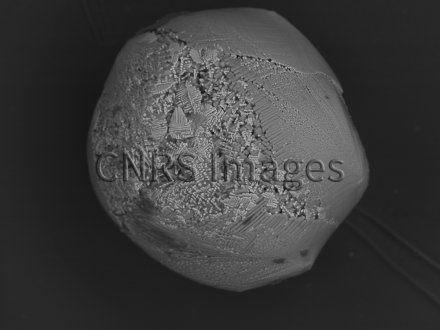Production year
2021

© Lucie DELAUCHE / Cécile ENGRAND / Jean DUPRAT / IJCLab / IMPMC / CNRS Images
20210137_0011
Particles of cosmic dust from comets or asteroids, known as micrometeorites, have always fallen on our planet. Some of these are spherules, micrometeorites that have totally or partially melted on entering the atmosphere. The spherule shown here has a diameter of 170 micrometres. Its surface reveals pale-coloured, dendritic (tree-like) crystals of magnetite that formed as a result of the interaction of the molten meteorite with oxygen in the atmosphere as it solidified. This cosmic dust grain is just one of some 5 200 tonnes of micrometeorites that reach the Earth’s surface every year. Studying this dust, which was collected in central Antarctica near the French-Italian Concordia Station, sheds new light on how our star and its planets formed, 4.5 billion years ago. This image is a winner of the 2021 La preuve par l'image (LPPI) competition.
The use of media visible on the CNRS Images Platform can be granted on request. Any reproduction or representation is forbidden without prior authorization from CNRS Images (except for resources under Creative Commons license).
No modification of an image may be made without the prior consent of CNRS Images.
No use of an image for advertising purposes or distribution to a third party may be made without the prior agreement of CNRS Images.
For more information, please consult our general conditions
2021
Our work is guided by the way scientists question the world around them and we translate their research into images to help people to understand the world better and to awaken their curiosity and wonderment.